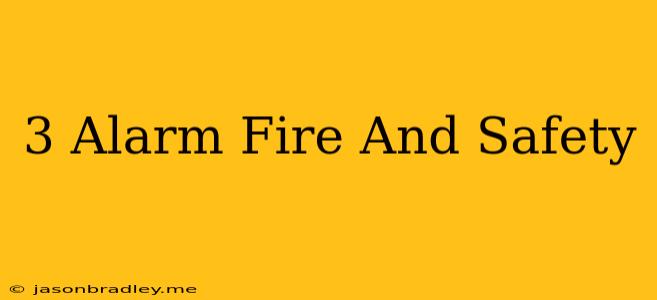Understanding 3-Alarm Fires: What They Mean and How to Stay Safe
A "3-alarm fire" is a term used to describe a large and serious fire that requires a significant response from the fire department. This term, however, isn't a technical term, but rather a way to communicate the severity of the situation.
What Determines a 3-Alarm Fire?
The number of alarms dispatched for a fire is determined by several factors, including:
- The size and intensity of the fire: Larger fires, especially those involving multiple buildings or structures, often necessitate more resources.
- The potential for spread: Fires in densely populated areas or those threatening nearby buildings are more likely to trigger a higher alarm response.
- The type of building or structure: Fires in high-rise buildings, hospitals, or other critical infrastructure often require a more substantial response.
- Available resources: The number of fire engines, ladders, and other equipment available in a particular area can influence the number of alarms dispatched.
Why is a 3-Alarm Response Necessary?
A 3-alarm fire requires a large number of firefighters and resources to effectively combat the blaze and ensure the safety of everyone involved. This response aims to:
- Contain the fire: Additional firefighters help to prevent the fire from spreading to nearby structures and contain it within the affected area.
- Provide manpower: Large fires require numerous firefighters to operate hoses, ladders, and other equipment simultaneously.
- Address the complex nature of the fire: The intensity and size of a 3-alarm fire often require specialized equipment and tactics, which necessitate a greater number of personnel.
- Ensure firefighter safety: A larger response ensures that firefighters have enough backup and support to work safely in a challenging environment.
Safety Tips During a 3-Alarm Fire:
If you find yourself near a 3-alarm fire, it's crucial to prioritize your safety:
- Evacuate immediately: If instructed to evacuate, do so quickly and calmly. Follow the directions of emergency personnel.
- Stay away: Keep a safe distance from the fire. The heat, smoke, and falling debris pose significant risks.
- Stay informed: Monitor local news and emergency alerts for updates on the fire's progress and safety instructions.
- Call for help: If you or someone you know needs assistance, contact emergency services immediately.
Remember, a 3-alarm fire is a serious incident that requires a coordinated response from emergency services. Staying informed and following safety guidelines can help ensure your safety and minimize potential risks.
